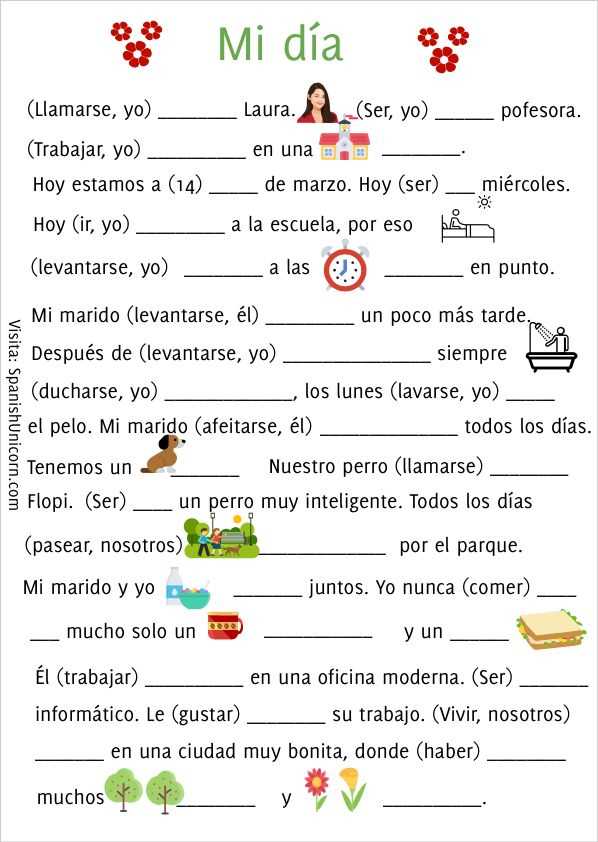
Learning Spanish can be a challenging but rewarding experience. One aspect of the language that many students find difficult is the use of reflexive verbs. These verbs require the use of a reflexive pronoun that refers back to the subject of the sentence. In order to practice using reflexive verbs correctly, it can be helpful to have a worksheet with answers to check your understanding. This article will provide you with some sample answers for a “Los verbos reflexivos” worksheet.
First, let’s review the concept of reflexive verbs. Reflexive verbs are a type of verb in which the subject also receives the action of the verb. They are commonly used to talk about actions that someone does to or for themselves. For example, “lavarse” means “to wash oneself” and “ducharse” means “to shower oneself.”
Now, let’s look at some sample answers for a “Los verbos reflexivos” worksheet. In the first exercise, students may be asked to conjugate the reflexive verb “levantarse” (to get up) in the present tense. The correct answers would be:
- Yo me levanto
- Tú te levantas
- Él/Ella/Usted se levanta
- Nosotros/Nosotras nos levantamos
- Vosotros/Vosotras os levantáis
- Ellos/Ellas/Ustedes se levantan
In the second exercise, students may be asked to complete the sentences with the appropriate reflexive pronoun. For example:
- Yo me lavo las manos antes de comer.
- Tú te cepillas los dientes por la mañana.
- Él/Ella/Usted se viste elegante para la fiesta.
- Nosotros/Nosotras nos acostamos temprano los fines de semana.
- Vosotros/Vosotras os maquilláis antes de salir.
- Ellos/Ellas/Ustedes se peinan antes de ir al trabajo.
In conclusion, having a worksheet with answers can be a helpful tool for practicing and reinforcing your understanding of reflexive verbs. By studying and reviewing the correct answers, you can improve your ability to use reflexive verbs correctly in Spanish.
What are reflexive verbs?
Reflexive verbs are a specific type of verb in Spanish that indicate that the subject of the verb is also the recipient of the action. They are formed by adding a reflexive pronoun to the verb, which agrees with the subject. In English, reflexive verbs are often translated with the pronouns “myself,” “yourself,” “himself,” etc.
Reflexive verbs are used to express actions that individuals do to themselves or for themselves. They are commonly used to talk about daily routines, personal care activities, and emotions. Some examples of reflexive verbs in Spanish include “lavarse” (to wash oneself), “vestirse” (to get dressed), and “sentirse” (to feel). These verbs are conjugated in the same way as regular verbs, but with the addition of the reflexive pronoun.
When using reflexive verbs, it’s important to remember that the reflexive pronoun must agree with the subject. For example, “me lavo” means “I wash myself,” while “te lavas” means “you wash yourself.” The reflexive pronouns in Spanish are “me” (myself), “te” (yourself), “se” (himself/herself/itself), “nos” (ourselves), and “os” (yourselves).
Overall, reflexive verbs are an essential part of Spanish grammar and are used to indicate when a subject performs an action on themselves. They add depth and nuance to conversations, allowing speakers to express personal care activities, daily routines, and emotions. Learning how to use reflexive verbs correctly is an important step in becoming fluent in Spanish.
How do reflexive verbs work in Spanish?
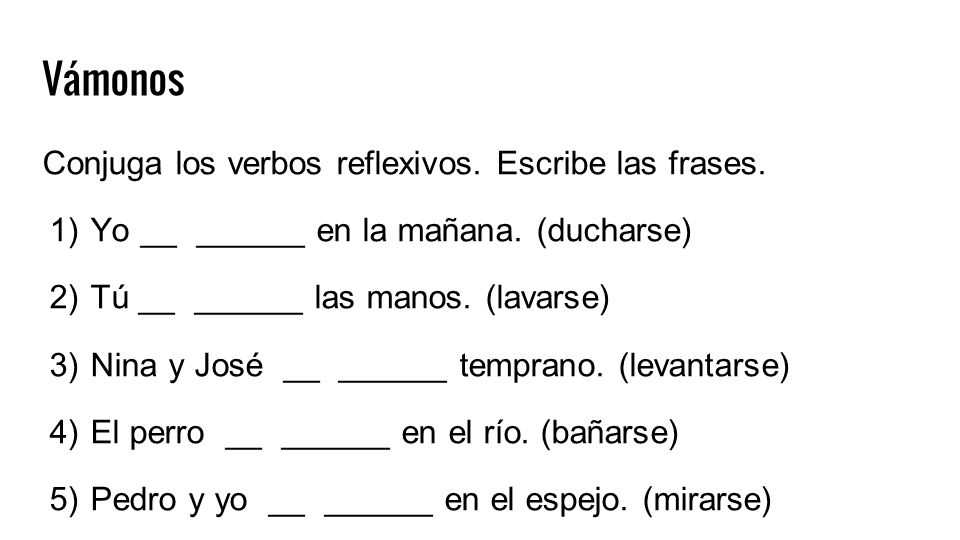
Reflexive verbs are a unique aspect of the Spanish language. They are verbs that are used when the subject of the action is also the object of the action. In other words, the subject is doing the action to itself. Reflexive verbs are formed by adding the reflexive pronoun “se” to the end of the infinitive verb.
For example, the reflexive verb “bañarse” means “to bathe oneself” in English. The subject of the action is the person who is bathing, and they are also the object of the action. So, you would say “yo me baño” (I bathe myself) or “él se baña” (he bathes himself).
Reflexive verbs are used in a variety of situations in Spanish. They can be used to express daily routines and personal care activities, such as getting dressed (“vestirse”), brushing your teeth (“cepillarse los dientes”), or combing your hair (“peinarse”). Reflexive verbs can also be used to describe emotions or feelings, such as feeling happy (“sentirse feliz”) or feeling tired (“sentirse cansado”).
It’s important to note that reflexive verbs in Spanish have a different conjugation pattern than regular verbs. When conjugating reflexive verbs, the reflexive pronoun “se” changes based on the subject of the verb. For example, “me baño” (I bathe myself) is conjugated with the reflexive pronoun “me” for the first-person singular, while “te bañas” (you bathe yourself) is conjugated with the reflexive pronoun “te” for the second-person singular.
Overall, reflexive verbs are an integral part of Spanish grammar and are used to express actions that involve the subject doing the action to themselves. With practice, mastering reflexive verbs can greatly enhance your Spanish language skills.
Benefits of Using Worksheets for Practicing Reflexive Verbs
Using worksheets for practicing reflexive verbs can greatly enhance the learning experience for students. These worksheets provide structured exercises and activities that allow students to practice and reinforce their understanding of reflexive verbs in a focused and systematic way.
One of the main benefits of using worksheets is that they provide a clear and organized format for practicing reflexive verbs. The worksheets typically include a variety of exercises, such as fill in the blanks, matching, and sentence completion, which help students practice both the conjugation and usage of reflexive verbs. This structured approach helps students build their knowledge and confidence gradually, as they progress through the exercises.
Additionally, worksheets can also provide immediate feedback to students, allowing them to self-assess their understanding and progress. Many worksheets include answer keys, which students can use to check their work and identify any errors or areas for improvement. This feedback loop is crucial for students to identify their strengths and weaknesses and take ownership of their learning process.
Moreover, worksheets can be used as a valuable resource for individual or independent practice. Students can work on the worksheets at their own pace, allowing them to focus on specific areas they find challenging. This self-directed practice not only promotes autonomy but also allows students to reinforce their understanding and mastery of reflexive verbs at their own comfort level.
In conclusion, worksheets provide a structured and organized approach to practicing reflexive verbs, offering a range of exercises and activities that facilitate learning and reinforcement. With the ability to provide immediate feedback and promote independent practice, worksheets can be a valuable tool for students to enhance their understanding and fluency in using reflexive verbs.
Why use worksheets?
Worksheets are a valuable tool for educators and learners alike. They provide a structured and organized way to practice and reinforce concepts and skills. Through worksheets, students can engage in hands-on activities, problem-solving exercises, and critical thinking tasks. They offer a tangible and interactive learning experience that helps students actively participate in their own education.
One of the main benefits of using worksheets is that they allow students to work independently and at their own pace. This promotes self-directed learning and gives students the opportunity to take ownership of their educational journey. Worksheets can be used as a formative assessment tool, allowing teachers to gauge students’ understanding of the material and tailor their instruction accordingly.
Moreover, worksheets can be modified and customized to meet the specific needs and abilities of individual students. They can be adapted to cater to different learning styles, accommodate diverse learners, and provide additional support for struggling students. Worksheets also facilitate differentiated instruction by offering various levels of difficulty and complexity.
- Worksheets provide a structured and organized way to practice and reinforce concepts and skills.
- They offer a tangible and interactive learning experience.
- Students can work independently and at their own pace.
- Worksheets can be modified and customized to meet individual needs.
- They facilitate differentiated instruction.
In conclusion, worksheets are a valuable educational tool that can enhance student learning and engagement. They provide opportunities for practice, self-directed learning, assessment, and differentiation. By incorporating worksheets into their teaching practice, educators can create a dynamic and effective learning environment that supports student success.
How do worksheets help with learning and practicing reflexive verbs?
Worksheets play a crucial role in helping learners understand and practice reflexive verbs in a structured and interactive way. These worksheets provide learners with a variety of exercises and activities that focus specifically on reflexive verbs, allowing them to reinforce their understanding and improve their usage of these verbs in different contexts.
One way worksheets assist in learning reflexive verbs is through providing clear explanations and examples. These resources often include explanations of what reflexive verbs are and how they function in sentences. By presenting clear examples, learners can easily grasp the concept and start recognizing these verbs in context.
Additionally, worksheets offer opportunities for learners to practice conjugating reflexive verbs in different tenses and moods. They provide exercises where learners have to fill in the correct form of the reflexive verb or match the reflexive pronoun with the correct verb form. This repetitive practice helps learners internalize the correct conjugation patterns and usage of reflexive verbs.
Furthermore, worksheets incorporate interactive activities such as fill-in-the-blank exercises, sentence completion, and sentence transformation that allow learners to actively engage with reflexive verbs. These activities challenge learners to manipulate the reflexive verbs in order to form grammatically correct sentences, promoting a deeper understanding of their usage and meaning.
In conclusion, worksheets are valuable tools for learning and practicing reflexive verbs. By providing clear explanations, ample opportunities for practice, and interactive activities, worksheets enable learners to enhance their understanding and usage of reflexive verbs in a meaningful way.
Techniques for Using Worksheets to Answer Reflexive Verbs
Worksheets can be a useful tool for practicing and reinforcing the use of reflexive verbs in Spanish. By providing structured exercises and guided practice, worksheets can help students improve their understanding and use of these verbs in a variety of contexts. Here are some techniques for effectively using worksheets to answer reflexive verbs:
1. Providing Clear Instructions: Begin by clearly explaining the concept of reflexive verbs and their usage to the students. Clearly state the objectives of the worksheet and explain any specific instructions or guidelines they need to follow.
2. Using Authentic Examples: Include authentic examples of reflexive verb usage in context to help students understand the concept better. Provide sentences or short texts where reflexive verbs are used and ask students to identify the verb and its reflexive pronoun.
3. Fill in the Blanks: Provide sentences with missing reflexive pronouns or forms of the verb. Ask students to complete the sentences by choosing the correct reflexive pronouns or conjugating the verb appropriately. This exercise helps students practice both their understanding and application of reflexive verbs.
4. Matching Exercises: Create matching exercises where students need to match reflexive verbs with their corresponding reflexive pronouns or vice versa. This type of exercise helps students reinforce their knowledge of which pronouns are used with certain verbs.
5. Role-playing Scenarios: Design worksheets that require students to role-play different scenarios using reflexive verbs. For example, provide a dialogue between two people and ask students to rewrite it using reflexive verbs to describe daily routines or personal experiences.
6. Error Correction: Include sentences with errors in the use of reflexive verbs and ask students to identify and correct them. This activity helps students develop their ability to recognize and correct common mistakes in the usage of reflexive verbs.
By using these techniques, worksheets can become valuable tools for students to improve their understanding and use of reflexive verbs. These structured exercises provide practice in a variety of contexts and help students internalize the correct usage of reflexive verbs in Spanish.
Step-by-step instructions for completing the worksheet
Completing the “Los verbos reflexivos” worksheet is a great way to practice and enhance your understanding of reflexive verbs in the Spanish language. This worksheet focuses on identifying and conjugating reflexive verbs correctly in various sentences. To successfully complete the worksheet, follow these step-by-step instructions:
1. Read the instructions:
The worksheet will provide a set of instructions explaining the task you need to complete. Carefully read and understand these instructions before proceeding.
2. Identify the reflexive verb:
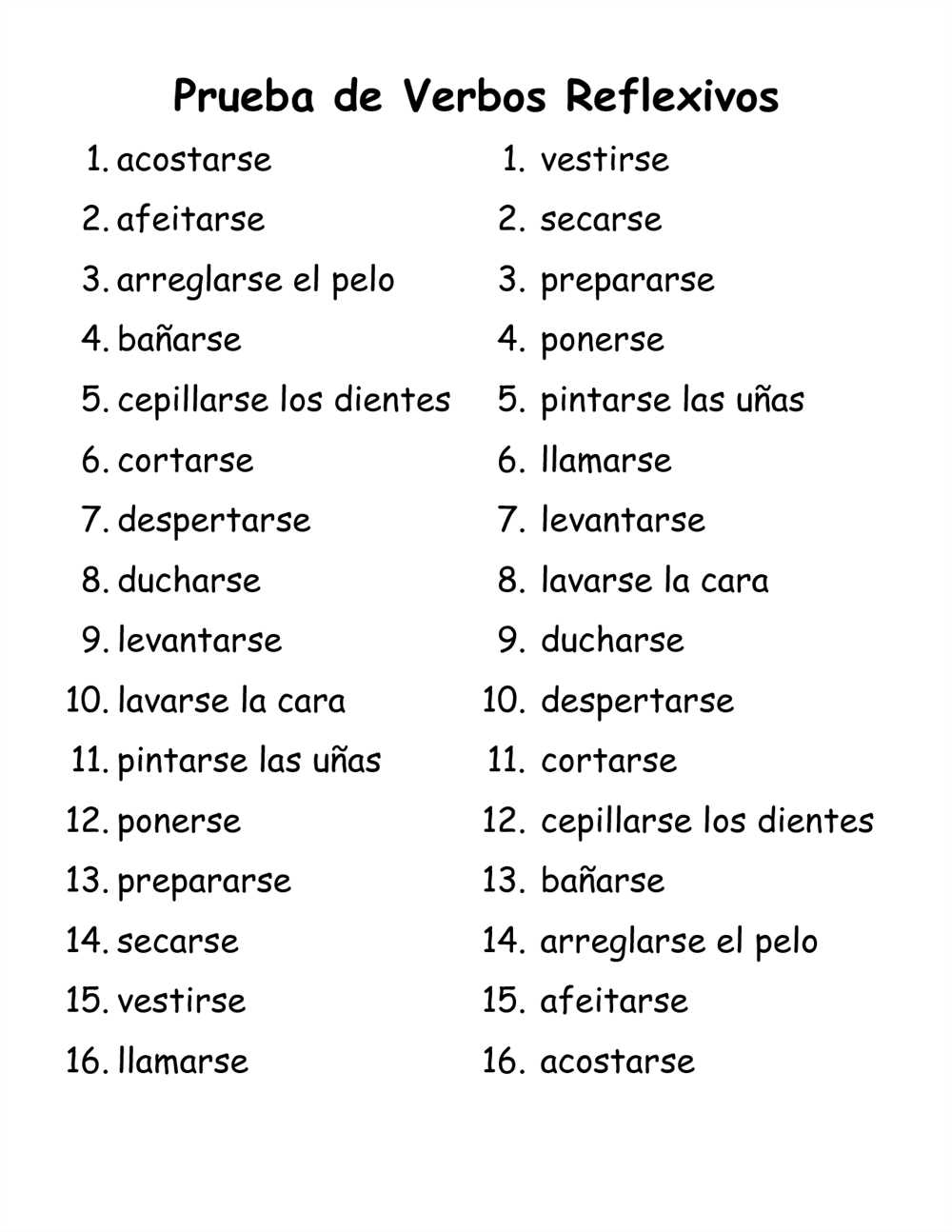
Each sentence in the worksheet will contain a reflexive verb. Identify the reflexive verb in the sentence and underline it. Remember that reflexive verbs are used when the subject of the sentence also receives the action of the verb.
3. Determine the pronoun:
Once you have identified the reflexive verb, determine the appropriate reflexive pronoun that corresponds to the subject of the sentence. Reflexive pronouns include “me,” “te,” “se,” “nos,” and “se,” depending on the subject.
4. Conjugate the verb:
Using the reflexive pronoun, conjugate the reflexive verb in the appropriate tense and form that matches the subject of the sentence. Pay attention to verb endings, irregularities, and any necessary changes in the stem of the verb.
5. Fill in the blanks:
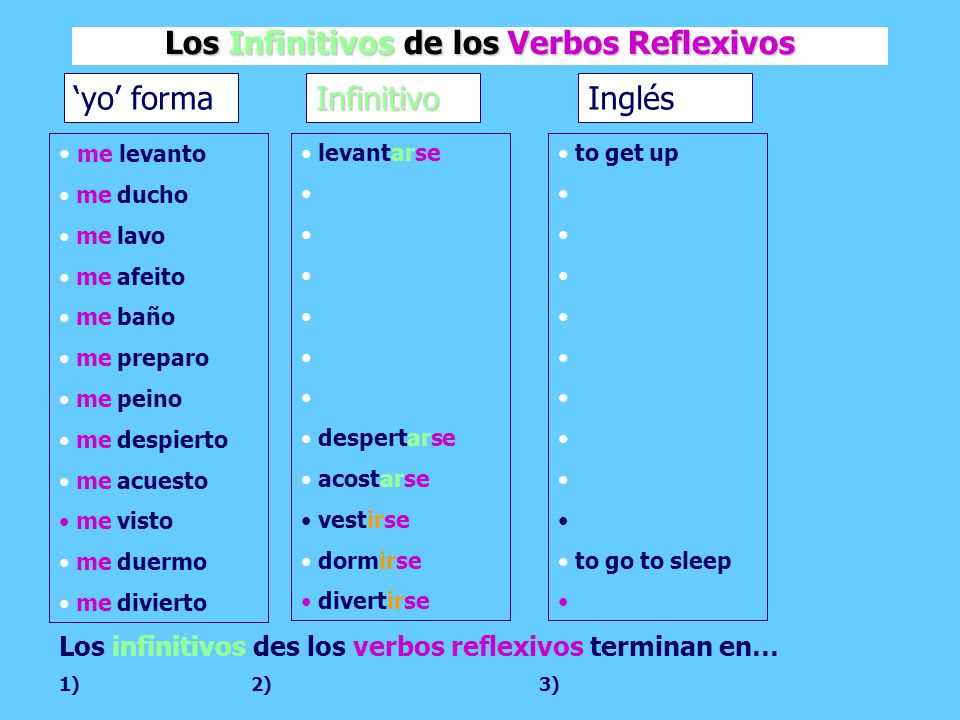
On the worksheet, you will find a series of sentences with gaps where the reflexive verb needs to be filled in. Write your conjugated reflexive verb in the blank spaces provided, making sure it matches the subject and tense specified in the sentence.
6. Check your answers:
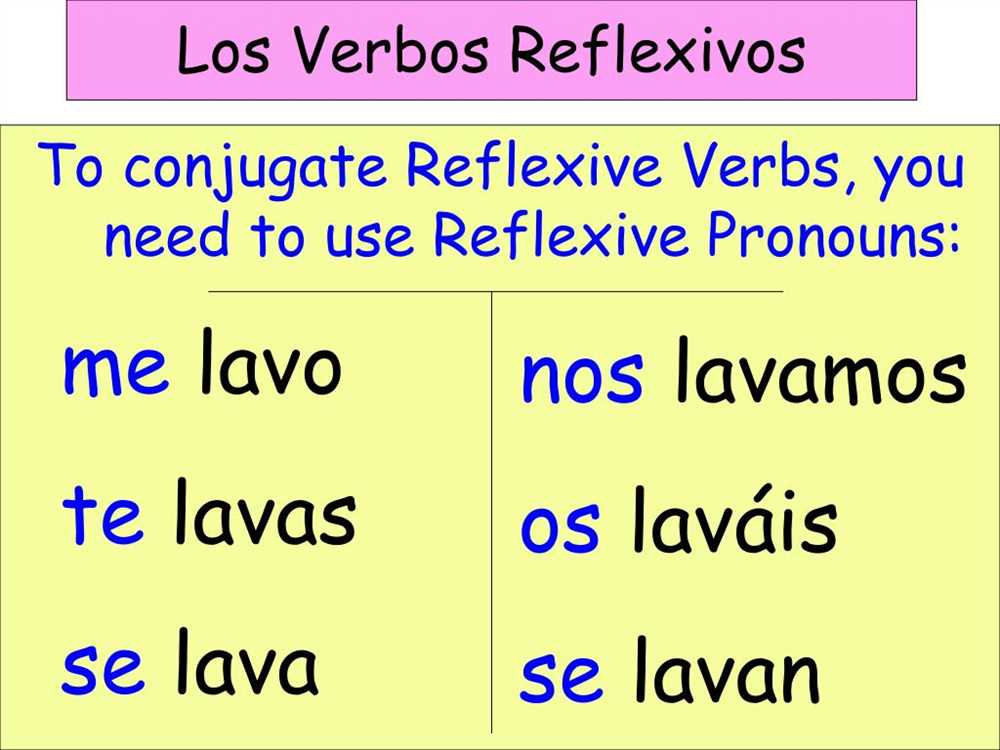
After completing the worksheet, carefully review your answers and compare them with the provided answer key. Make any necessary corrections and ensure that your conjugated reflexive verbs are accurate and grammatically correct.
By following these step-by-step instructions, you will successfully complete the “Los verbos reflexivos” worksheet and improve your understanding and proficiency in using reflexive verbs in Spanish.